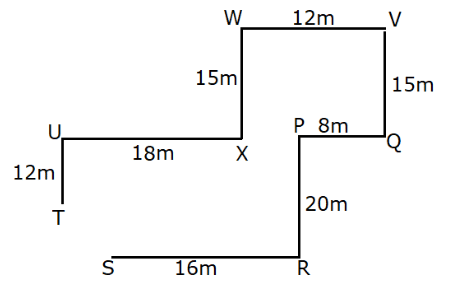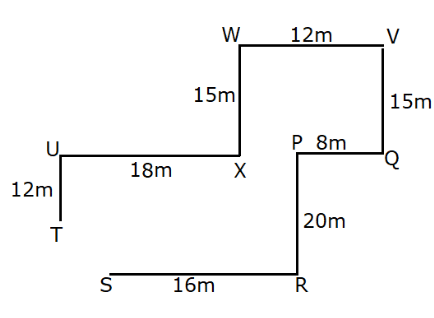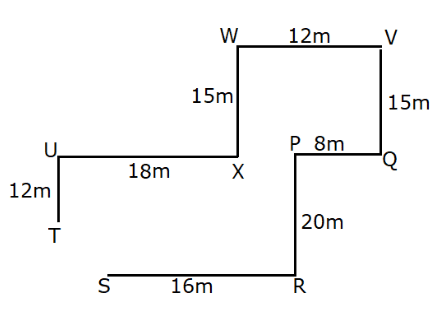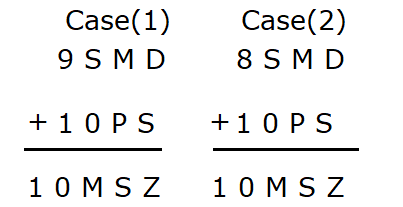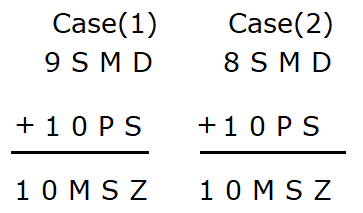SBI PO Mains Mock Test - 8 - Bank Exams MCQ
30 Questions MCQ Test - SBI PO Mains Mock Test - 8
Study the following information carefully and answer the below questions.
In a certain machine code ‘@’ means ‘0’, ‘*’ means ‘1’, and ‘*@’ means ‘2’.
A#B(*@@*) means “A is 7m west of B”.
A&B(**@@) means “A is 15m east of B”.
A%B(@*@*) means “A is 9m north of B”.
A^B(**@*) means “A is 16m south of B”.
Condition: W#V(***@), Q^V(**@@), X&U(****), W%X(*@**), S#R(*@@*@), P%R(*@@@@), T^U(*@@*), Q&P(@*@*).
What is the position of S with respect to T?
Study the following information carefully and answer the below questions.
In a certain machine code ‘@’ means ‘0’, ‘*’ means ‘1’, and ‘*@’ means ‘2’.
A#B(*@@*) means “A is 7m west of B”.
A&B(**@@) means “A is 15m east of B”.
A%B(@*@*) means “A is 9m north of B”.
A^B(**@*) means “A is 16m south of B”.
Condition: W#V(***@), Q^V(**@@), X&U(****), W%X(*@**), S#R(*@@*@), P%R(*@@@@), T^U(*@@*), Q&P(@*@*).
What is the position of X with respect to P?
Study the following information carefully and answer the below questions.
In a certain machine code ‘@’ means ‘0’, ‘*’ means ‘1’, and ‘*@’ means ‘2’.
A#B(*@@*) means “A is 7m west of B”.
A&B(**@@) means “A is 15m east of B”.
A%B(@*@*) means “A is 9m north of B”.
A^B(**@*) means “A is 16m south of B”.
Condition: W#V(***@), Q^V(**@@), X&U(****), W%X(*@**), S#R(*@@*@), P%R(*@@@@), T^U(*@@*), Q&P(@*@*).
If Ramya walks **@* meter towards west from point S, then takes a right turn of *@@** meter to reach point M, then what is the position of point U with respect to M?
Directions: In the question below is given a statement followed by two courses of action numbered I and II. You have to assume everything in the statement to be true and on the basis of the information given in the statement, decide which of the suggested courses of action logically follow for pursuing.
Statement: A recent study shows that students die in Kota mainly because of depression.
Courses of action:
I. The counseling centers in cities like Kota should be encouraged for students.
II. Parents should stop sending their ward to Kota.
Given below are pairs of events A and B. You have to read both the events A and B and decide their nature of relationship. You have to assume that the information given in A and B is true and you will not assume anything beyond the given information while deciding the answer. Mark answer.
Event (A): More than 11.5 lakh saplings are being planned to be planted across the city and school children will be advised to take care of 2 saplings each.
Event (B): City corporation has decided to convert abandoned quarries in and around the city to be filled scientifically and reclaimed for conversion into tree parks by planting of saplings.
A phrase is coded step by step in following certain rules. Study the following information carefully and answer the below questions.

A phrase is coded step by step in following certain rules. Study the following information carefully and answer the below questions.

Q. Which of the following correctly represent “HARVEST” in step I?
A phrase is coded step by step in following certain rules. Study the following information carefully and answer the below questions.

A phrase is coded step by step in following certain rules. Study the following information carefully and answer the below questions.

Q. Which of the following correctly represent step III for phrase?MAGICAL HAVE COUNT
Directions: In this question, the relationship between different elements is shown in the statements. These statements are followed by two conclusions.
Statement: C ≥ M > F < A = B > S
Conclusions:
I. C > B
II. F < S
Statement: “Good news for all, Vikalp is available and every passenger will get reserve seats. Waiting status will be omitted from reservation chart” quoted by Railways Ministry. Spokesperson of railways has said if confirm seat is not available in desired train, option for confirm seat in other train will be given at the time of reservation.
Which of the following can be assumed from the given statement?
(I) Commuters would have faced issues regarding confirm seats in railways.
(II) Fairs of reserved seats will be increased by Railways department.
(III) There will be increase in number of persons travelling through railways.
Below questions consist of numbers in three rows. Results from each row can be obtained by applying certain rules given below. Study the following information carefully and answer the below questions.
Condition:
I. If an even number is followed by a prime number, then the product of the tenth digit of the numbers is taken.
II. If an odd (non-prime) is followed by an even number, then the sum of numbers is taken.
III. If a prime number is followed by a perfect square number, then the difference between the numbers is taken.
IV. If a prime number is followed by a composite number, then divide the second number by the first number.
V. If an even number is followed by a perfect cube number, then the product of unit digits of numbers is taken.
If more than one condition is applied then only one condition is applied as per the order.
Q. What is the sum of the resultant of all three rows?
7 25 27
38 31 24
13 39 49
Below questions consist of numbers in three rows. Results from each row can be obtained by applying certain rules given below. Study the following information carefully and answer the below questions.
Condition:
I. If an even number is followed by a prime number, then the product of the tenth digit of the numbers is taken.
II. If an odd (non-prime) is followed by an even number, then the sum of numbers is taken.
III. If a prime number is followed by a perfect square number, then the difference between the numbers is taken.
IV. If a prime number is followed by a composite number, then divide the second number by the first number.
V. If an even number is followed by a perfect cube number, then the product of unit digits of numbers is taken.
If more than one condition is applied then only one condition is applied as per the order.
Q. What is the product of the digital sum of the resultant of all three rows?
9 4 91
14 27 73
5 30 8
Below questions consist of numbers in three rows. Results from each row can be obtained by applying certain rules given below. Study the following information carefully and answer the below questions.
Condition:
I. If an even number is followed by a prime number, then the product of the tenth digit of the numbers is taken.
II. If an odd (non-prime) is followed by an even number, then the sum of numbers is taken.
III. If a prime number is followed by a perfect square number, then the difference between the numbers is taken.
IV. If a prime number is followed by a composite number, then divide the second number by the first number.
V. If an even number is followed by a perfect cube number, then the product of unit digits of numbers is taken.
If more than one condition is applied then only one condition is applied as per the order.
Q. If the result of the sum of all three rows is 41, then what is the value of Y?
24 29 8
13 Y 53
4 64 43
Directions: In this question, the relationship between different elements is shown in the statements. These statements are followed by two conclusions.
Statement: H = M ≤ W; C ≥ W < S
Conclusions:
I. C = M
II. C > M
The argument about whether demonetisation was good or bad for the economy refuses to die down even a year after the event. While one can endlessly debate, with very little data, on whether the ban on high-value currency notes dealt a body blow to terrorism, corruption and counterfeiting, one area in which its impact can be quantified with data is tax compliance. In FY18, net collections increased by 17.1%.
Which of the following can be postulated from the given statement?
I. Counterfeiting of notes was one of the major concern for Government of India.
II. Many economists has termed it wrong as it has impact badly on the weaker section of the society.
III. There has been revamp in the percentage increase of direct tax with respect to indirect tax.
Study the following information carefully and answer the below questions.
In a machine language numbers from 0 to 9 are coded as different letters of alphabetical order. Each digit can be coded with only one letter. Now, study the below arithmetic problem given below.
B S M D + H L P S = H L M S Z
What is the perfect square of HD?
Study the following information carefully and answer the below questions.
In a machine language numbers from 0 to 9 are coded as different letters of alphabetical order. Each digit can be coded with only one letter. Now, study the below arithmetic problem given below.
B S M D + H L P S = H L M S Z
What is the product of SD?
Direction: In the question below is given a statement followed by three assumptions numbered I, II and III. An assumption is something supposed or taken for granted. You have to consider the following assumption and decide which of the assumption is implicit in the statement.
Statement: The Indian authorities have allowed commercial operations to all the airports that were shut after a few fighter jets of the Pakistani Air Force entered the Indian side of Kashmir. The authorities had informed all airlines that airports near the Jammu & Kashmir region and Dehradun have been closed.
Assumptions:
I. The Pakistani Air Force entered the Indian side of Kashmir after the Indian Air Force entered the Pakistani territory and bombed a terrorist training center in Pakistan.
II. Several airline executives confirmed that the government has informed them that flights to Jammu, Srinagar, Leh, Amritsar, Dehradun & Dharamshala have been suspended ‘till further notice.’
III. One official added that no Notice to Airmen (NOTAM) has been issued yet. It is a notification to the government that the airlines have received, the source in the know said.
In the following questions is based on a short argument, a set of statements, or a plan of action. For each question, select the best answer from the given choices.
Energy consumption involves release of greenhouse gases resulting in global warming. Hence, it is the contention of the under-developed nations that the economically developed countries must make a higher contribution to funds constituted towards taking measures to fight global warming.
Which of the following is an assumption in the above argument?
In May 2025, which of the following statements about the Pradhan Mantri Fasal Bima Yojana (PMFBY) claims settlement are correct?
1. 97% of the total claims under PMFBY and the Restructured Weather-Based Crop Insurance Scheme have been settled.
2. Goa, Chhattisgarh, Telangana, and Tamil Nadu are the top states with 100% claim settlement under these schemes.
3. only covers Rabi crops and does not include Kharif or horticultural crops.
In May 2025, Cristiano Ronaldo, one of football's greatest players, has consistently broken records throughout his illustrious career. In May 2025, he reached a historic milestone by scoring his 800th club goal. Ronaldo's journey to 800 goals includes remarkable contributions for top European clubs. What is the name of the club where he scored his 800th goal?
In June 2025, Adani Airports Holdings Ltd secured a significant round of funding aimed at refinancing its existing debt and advancing infrastructure development at several of its major airports across the country. This was facilitated by a consortium of global banks, highlighting the confidence international financial institutions have in Adani's ambitious growth plans. The financing through External Commercial Borrowings (ECB) is crucial. What was the total amount that Adani Airports raised via ECB for its expansion and infrastructure development initiatives?
In July 2025, Which of the following statements regarding MapmyIndia’s Mappls App and its integration with DIGIPIN are correct?
1. MapmyIndia partnered with India Post to integrate the DIGIPIN platform into its Mappls app, creating a digital address system.
2. DIGIPIN allows users to generate a 5-character alphanumeric digital address with 3.8m x 3.8m grid-level accuracy.
3. The platform was developed by IIT Hyderabad, NRSC, and ISRO.
In June 2025, In a significant diplomatic development, India has been elected as one of the 18 new members to a principal organ of the United Nations tasked with coordinating economic, social, and environmental activities. For which term has India been elected to the UN Economic and Social Council (ECOSOC)?
In July 2025, In an effort to promote dignity, safety, and social security for sanitation workers, the Government of India is implementing the National Action for Mechanized Sanitation Ecosystem (NAMASTE) scheme across more than 4,800 urban local bodies. As part of this initiative, Union Minister of State B.L. Verma, in July 2025, launched a dedicated welfare helpline for waste pickers, alongside the distribution of PPE kits and Ayushman Bharat cards. Which of the following helpline numbers was launched for the welfare of waste pickers under the NAMASTE scheme?
In July 2025, Which of the following statements about the Indian Navy’s receipt of the stealth frigate Udaygiri and Project 17A are correct?
1. The Indian Navy received the stealth frigate Udaygiri from Mazagon Dock Shipbuilders Limited (MDL) as part of Project 17A.
2. The first ship under Project 17A, INS Nilgiri, was launched at Mazagon Dock Shipbuilders Limited.
3. The Udaygiri frigate is designed to operate only in the coastal waters of India.
In May 2025, the world lost Robert Benton, a legendary filmmaker who left an indelible mark on the cinematic world. At the age of 92, Benton passed away, leaving behind a legacy of outstanding contributions to the film industry, including three Academy Awards. Benton’s remarkable career spanned decades, and his films are remembered for their unique storytelling and character driven narratives. What was the title of the film for which Robert Benton won his very first Academy Award, marking the beginning of his remarkable journey in the film industry?
In May 2025, the National Statistical Office (NSO), under the Ministry of Statistics and Programme Implementation (MoSPI), released its ‘Comprehensive Modular Survey: Telecom, 2025’ report. The findings revealed that a large percentage of rural women in India aged 15 years and above do not own a mobile phone, underlining the digital divide and gender disparities in technology access. According to the NSO's ‘Comprehensive Modular Survey: Telecom, 2025’ report, what percentage of rural women in India aged 15 years and above do not own a mobile phone?
In May 2025, which of the following statements about Razorpay’s launch of India’s first AI-integrated MCP server for payments is not correct?
1. The MCP server allows businesses to integrate AI-driven systems directly with payment infrastructures to perform tasks like refunds and managing transactions.
2. Razorpay’s AI integration eliminates the need for business dashboards or APIs for payment authorisations.
3. The Model Context Protocol (MCP) server was developed by Razorpay’s in-house team without external collaborations.


